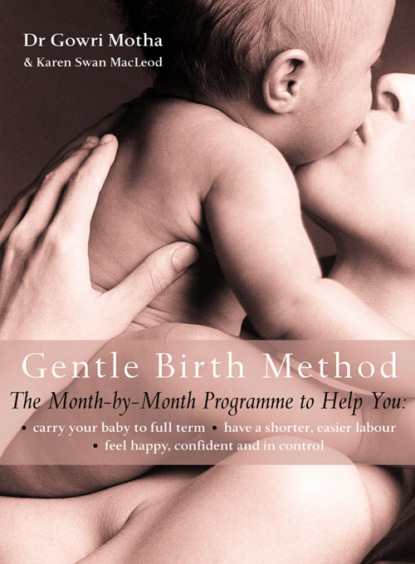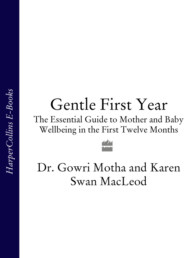По всем вопросам обращайтесь на: info@litportal.ru
(©) 2003-2024.
✖
The Gentle Birth Method: The Month-by-Month Jeyarani Way Programme
Автор
Год написания книги
2018
Настройки чтения
Размер шрифта
Высота строк
Поля
What is it?
A specially-devised massage that stretches and softens the lower vaginal tissues, preparing them for the delivery of the baby’s head.
Its pedigree
Early forms of this technique have been routinely practised in India and Africa for hundreds of years. In India, the Ayurvedic preparation for birth includes a vaginal ‘picchu’, which involves inserting a medicated oil-soaked bundle of soft cotton into the vagina to soften the tissues. In Africa, a similar method is practised using herbs, combined with a vaginal stretching technique. They make a bundle of herbs and insert it into the vagina. The bundle size is increased as term approaches. (The herbs are sometimes wrapped in muslin). I have combined both methods and since introducing it to the programme, the incidence of vaginal tears in my mothers has dropped to less than 4 per cent.
Perineal stretching in pregnancy
This procedure is to be practised daily after 36 weeks – DO NOT DO IT BEFORE THEN. It is a very important part of the programme because it reaches the parts deep muscle relaxation cannot sometimes reach. Even if our limbs are limp, the vaginal muscles can remain tense – generations of tucking in our tails, pulling in our tummies, riding, dancing and walking have meant our vaginal muscles have evolved to be tight.
What it can do for you
Create more space in the vagina for the delivery of the baby’s head
Reduce the second stage of labour (i.e. the pushing stage)
Reduce the incidence of vaginal and perineal tears
Reduce pain in the vagina and perineum during birth as the baby’s head is born
Reduce the sting or burning sensation of the crowning stage
Maximize the elasticity of the lower vaginal muscles and tissues
Soften the tissues around your vagina thereby reducing pressure effects of your baby’s head and reducing bruising
The distress experienced at the transition stage is often minimal or absent in mothers who practise the perineal stretch massage
Observing your body’s rapid response to the practice of vaginal stretching can increase your confidence in your ability to give birth
Less bruising means quicker recovery after birth
Can you do it yourself?
I recommend that your partner performs this massage technique for you, but you can also do it yourself. The method is described in detail on page 69.
Case History: Perineal Stretch Massage
I remember a pregnant client of mine who in the past had done lots of Ashtanga yoga, and whilst the rest of her muscles and tissues felt soft and were incredibly relaxed, her vaginal muscles and tissues felt like rock. At the first perineal examination at 36 weeks her lower vaginal muscles would not budge at all when pressed. I sent her home with some oil and instructions on how to do the vaginal and perineal stretch massage but thought it would be too late to soften such hard tissues. Within just three days of using the oil and performing the self-stretch she herself reported that she had noticed a big change in her vaginal elasticity and by the time she gave birth, three weeks later, her perineum was sufficiently soft to prevent any tearing at all – a great result despite a difficult start.
Home Massage Treatments
This section of the book is one of the most important. It really allows you to take charge and prepare your body for labour, rather than having to wait for your allotted time with a therapist. By performing these techniques at home, you can do them as often as you like (although no more than daily). I find many of my mothers really look forward to their treatments – and best of all, they’re free.
Remember to reciprocate and perform some massages on your partner (although obviously not the perineal stretch!) as it is vitally important your partner feels cherished too. It’s very easy for everything to centre on the mother, but these treatments can really help the father feel involved in the pregnancy.
Points for partners to remember (for the back, neck and tummy massage)
If in doubt, apply a light touch to begin with and gently increase pressure, with the mother’s guidance.
When you begin a massage, muscles can tense up initially, so encourage relaxation by softly stroking and massaging the area. Don’t go straight in with strong pressure.
These Creative Healing massages are very light. The pregnant mother should avoid deep body massage, as it can release toxins and cause unpleasant symptoms such as headaches and nausea.
Repetition is key. Massage is not about lots of different and dramatic moves. Even if you think it must be terribly boring for the mother, continue anyway. Drainage is maximized by repetition.
Make sure your hands are warm.
Creative Healing Massage
As I pointed out previously, there are four ‘intentions’ in Creative Healing – to normalize body temperature, to open and create drainage channels, to remove congestion, and to reposition substance. However, each of these intentions is not necessarily appropriate to all massage treatments – for example, in a heart treatment there is no repositioning of substance, only drainage and the removal of congestion.
The techniques that are used in Creative Healing are explained below, followed by instructions on how to massage particular areas. (Note: A demonstration of the entire Creative Healing massage techniques on DVD is available from Jeyarani – see Appendix C, page 314.)
Normalizing body temperature (cupping and taking the heat off)This does not relate to the body’s own innate temperature, but to heat in the local site of congestion. To normalize temperature, first compare skin temperature by lightly touching the back of your hand across the area you’re treating (the back of the hand is more sensitive to temperature differences). If there are any ‘hot spots’, cool them by cupping the hand and repetitively fanning downwards, without actually touching the skin – the aim is to create a ‘cooling breeze’. However, if an area is much cooler than other areas, it should be warmed up by briskly rubbing down the skin with the palms of alternate hands using a drop of oil.
Opening and creating drainage channelsIn Creative Healing drainage channels are created by making a superficial vacuum over the skin of the area to be treated. For example, downwards along the sides of the neck, upwards in the lower abdomen, across the chest for the heart, etc.
Breaking down congestionTo stimulate lymphatic flow in the area to be treated it is necessary to break down congestion. Areas of congestion feel like lumps or knots under the skin and these are broken down using little circular movements of the fingertips and thumbs.
To reposition substanceDisorders of body function can occur because nerve centres or cartilages are displaced in the body due to sudden movements. In Creative Healing, repositioning substance is part of the treatment in key areas such as the vertebrae, around the knee and shoulder joints and in the pubic area.
The General Treatment (Massage for the Neck, Shoulders and Back) (General lymphatic treatment and muscle release for the whole back) Minimum treatment time: 20 minutes
Benefits
Deeply relaxing
Reduces muscular tension in the whole of the back
Facilitates lymphatic drainage
Has amazing detoxifying effects
Provides anxiety relief
Increases musculoskeletal mobility to shorten labour
Encourages the baby’s head to engage
The purpose of this light massage technique is to help stimulate the lymphatic system, to drain the tissues, reduce oedema (swelling) and help the muscles work more efficiently. It can be an ideal time for the mother to practise simple relaxation and visualization phrases (we will look at this in detail in the next section) so that she links feelings of relaxation with pleasant touch and hypnotic triggers. The birth partner can help her with this, saying softly and slowly: ‘Take three deep breaths and whisper I’m going into self-hypnosis now’, or ‘Relax for me’, or ‘Let your mind drift to your safe place and feel safe there…’ For this treatment all you need is virgin olive oil. Some mothers ask if essential oils can be added to this and yes, of course, you can add a couple of drops of good quality organic lavender essential oils to about 50ml of olive oil. However, it isn’t advisable to complicate matters by adding a combination of oils to this, as the merits of Creative Healing are based on working on the energy lines and have nothing to do with the healing properties of essential oils (unlike Aromatherapy, for example).
The treatment is done with the mother sitting upright on a firm surface, such as a chair (sideways on, so that the back of the chair does not get in the way), stool, or bench. Note: All back treatments are done sitting up as lying down will close the spaces between the vertebrae and it will not be possible to treat the spine effectively. The mother’s upper back is exposed, but she can hold a towel in front of her body to prevent feeling exposed or cold. It is important for you to feel comfortable as well, so find a chair to sit on while administering the massage. Start by standing behind the mother, make sure your hands are warm, then place them on her shoulders and be still for a moment.
During this massage the whole of the back is worked on, so for ease of understanding the back and spinal area is divided into three sections. (By the way, don’t be put off by the medical jargon, it simply provides an accurate description of the spaces to be massaged.)
I) The upper back






